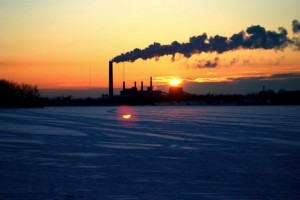Global Warming May Reduce U.S. Nuclear And Coal Power Output Up To 16 Percent By 2060
 Global warming will force a reduction in nuclear and coal electricity generation over the coming decades as a decline in freshwater resources makes it more difficult to cool thermoelectric power plants, say researchers.
Global warming will force a reduction in nuclear and coal electricity generation over the coming decades as a decline in freshwater resources makes it more difficult to cool thermoelectric power plants, say researchers.A new study published today in the journal Nature Climate Change projects that thermoelectric generation could fall by 4.4 to 16 percent in the U.S. between 2031 and 2060 due to a lack of adequate cooling water. Thermoelectric plants make up roughly 90 percent of the U.S. electricity mix — sucking up 40 percent of the nation’s freshwater supplies.
The researchers also projected a steeper decline in Europe, which could see a 19 percent dip in generation.
For cooling-water use, the combination of decreases in low river flows and increases in (especially high) water temperature is problematic. We used daily water temperature projections to calculate the mean number of days per year that water temperature is predicted to exceed the inlet limits of river water for cooling water use of 23°C (Europe) and 27°C (US). The increase in the number of days per year with water temperature exceeding 23°C is generally highest for southern Europe (median of 44–48 (59–82) days per year for B1–A2 scenario for the 2040s (2080s) relative to 23 days for 1971–2000). The same magnitude of increase in number of days with water temperatures exceeding 27°C is found for the south and southeastern US. Combined with projected decreases in low river flows of more than 25% in these regions, cooling-water problems are expected to be exacerbated substantially in the future.
The researchers also found that the likelihood of “extreme reductions” in electricity production of 90% or more at plants could increase by three-fold.
This emerging conflict is just one more headache for the ailing nuclear and coal industries in the U.S.
It’s been 16 years since a nuclear power plant was built in America. Southern Company is currently constructing a new plant in Georgia; however, the company recently reported that the project — once hailed as the start of a “renaissance” in nuclear — will cost almost $1 billion more than expected.
The coal industry has seen a steep decline in production, falling from 44.6 percent of U.S. electricity generation to 36 percent in just one year. A combination of aging infrastructure, cost-competitive renewables, new clean air regulations, and a strong anti-coal movement are quickly reducing the attractiveness of coal.
A warming planet will only accelerate the problems faced in these industries. The decline in adequate cooling water resources will force longer shutdowns, thus increasing the cost of electricity and raising more local environmental conflicts.
You can return to the main Market News page, or press the Back button on your browser.

